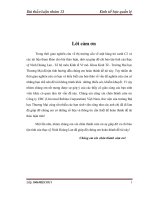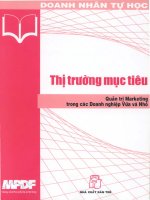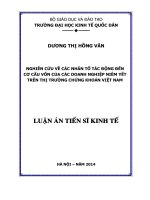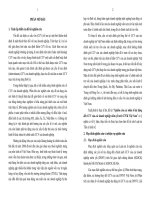Nghiên cứu về các đặc điểm ngữ nghĩa và ngữ pháp từ vựng trong truyện ngắn Ông biết tuốt của nhà văn Somerset Maugham. Phân tích theo quan điểm chức năng hệ thống.
Bạn đang xem bản rút gọn của tài liệu. Xem và tải ngay bản đầy đủ của tài liệu tại đây (304.94 KB, 14 trang )
VIETNAM NATIONAL UNIVERSITY, HANOI
UNIVERSITY OF LANGUAGES AND INTERNATIONAL STUDIES
FACULTY OF POST – GRADUATE STUDIES
************
NGUYỄN THI ̣ BÍ CH LIÊN
A STUDY ON THE SEMANTIC AND LEXICOGRAMMATICAL
FEATURES OF THE SHORT STORY MR KNOW ALL BY W.
SOMERSET MAUGHAM: A SYSTEMIC FUNCTIONAL ANALYSIS
NGHIÊN CỨU VỀ CÁC ĐẶC ĐIỂM NGỮ NGHĨA VÀ NGỮ PHÁP TỪ VỰNG
TRONG TRUYỆN NGẮN ÔNG BIẾT TUỐT CỦA NHÀ VĂN W.SOMERSET
MAUGHAM. PHÂN TÍ CH THEO QUAN ĐIỂM CHỨC NĂNG HỆ THỐNG
M.A. MINOR PROGRAMME THESIS
Field: English Linguistics
Code: 60220201
HANOI – 2016
VIETNAM NATIONAL UNIVERSITY, HANOI
UNIVERSITY OF LANGUAGES AND INTERNATIONAL STUDIES
FACULTY OF POST – GRADUATE STUDIES
************
NGUYỄN THI ̣ BÍ CH LIÊN
A STUDY ON THE SEMANTIC AND LEXICOGRAMMATICAL
FEATURES OF THE SHORT STORY MR KNOW ALL BY W.
SOMERSET MAUGHAM: A SYSTEMIC FUNCTIONAL ANALYSIS
NGHIÊN CỨU VỀ CÁC ĐẶC ĐIỂM NGỮ NGHĨA VÀ NGỮ PHÁP TỪ VỰNG
TRONG TRUYỆN NGẮN ÔNG BIẾT TUỐT CỦA NHÀ VĂN W.SOMERSET
MAUGHAM. PHÂN TÍ CH THEO QUAN ĐIỂM CHỨC NĂNG HỆ THỐNG
M.A. MINOR PROGRAMME THESIS
Field: English Linguistics
Code: 60220201
Supervisor: Prof. Dr. Hoàng Văn Vân
HANOI - 2016
TABLE OF CONTENTS
CANDIDATE’STATEMENT ................................................................................................ i
CKNOWLEDGEMENTS ..................................................................................................... ii
ABSTRACT.......................................................................................................................... iii
TABLE OF CONTENTS...................................................................................................... iv
PART I: INTRODUCTION
CHAPTER1:GENER LINTRODUCTION ........................................................................... 1
1.1. Rationale of the study ..................................................................................................... 1
1.2. Aims of the study and research questions ...................................................................... 2
1.3. Scope of the study .......................................................................................................... 3
1.4. Methods of the study....................................................................................................... 3
1.5. Design of the study ........................................................................................................ 3
PART II: DEVELOPMENT
CHAPTER 2: THEORETICAL BACKGROUND ............................................................... 5
2.1. Introduction .................................................................................................................... 5
2.2. Systemic Functional Linguistics .................................................................................... 6
2.2.1. Strata of the systemic functional model .............................................................. 7
2.2.2. Metafunctions ...................................................................................................... 8
2.3. The ideational meaning ................................................................................................... 9
2.3.1. Process types ................................................................................................. 10
2.3.1.1. Material process ......................................................................................... 10
2.3.1.2. Mental processes ........................................................................................ 10
2.3.1.3. Relational processes ................................................................................... 11
2.3.1.4. Behavioral processes ................................................................................. 12
2.3.1.5. Verbal processes ....................................................................................... 12
2.3.1.6. Existential processes .................................................................................. 13
2.3.2. Circumstances ............................................................................................... 13
2.4. The interpersonal meaning............................................................................................ 14
2.4.1. Constituents of the Mood ................................................................................... 15
2.4.2. Residue ............................................................................................................... 16
2.4.3. Mood types ........................................................................................................ 16
i
2.4.3.1. Indicative mood ......................................................................................... 17
2.4.3.2. Imperative mood ...................................................................................... 18
2.5. The textual meaning...................................................................................................... 18
2.5.1. Types of theme .................................................................................................. 19
2.5.1.1. Ideational or Topical theme ..................................................................... 19
2.5.1.2. Textual theme .......................................................................................... 20
2.5.1.3. Interpersonal theme.................................................................................. 20
2.5.2. Theme and mood ............................................................................................... 20
2.5.2.1. Theme in interrogatives ............................................................................ 21
2.5.2.2. Theme in imperatives ............................................................................... 21
2.5.2.3. Theme in declaratives .............................................................................. 21
2.5.2.4. Theme in exclaimatives ........................................................................... 22
2.6. Summary ....................................................................................................................... 22
CHAPTER 3: THE SEMANTIC AND LEXICOGRAMMATICAL FEATURES OF THE
SHORT STORY MR. KNOW ALL ..................................................................................... 23
3.1. W. Somerset Maugham and the story Mr. Know All .................................................. 23
3.2. The analysis of the story in terms of clause and clause complex ................................. 24
3.3. The analysis of the story in terms of transitivity ......................................................... 25
3.4. The analysis of the story in terms of mood .................................................................. 39
3.5. The analysis of the story in terms of theme ................................................................. 41
3.6. Summary ....................................................................................................................... 43
PART III: CONCLUSION
CHAPTER 4: CONCLUSION ............................................................................................ 44
4.1. Recapitulation ............................................................................................................... 44
4.2. Implications of the study.............................................................................................. 45
4.3. Suggestions for further study ....................................................................................... 45
REFERENCES .................................................................................................................... 46
APPENDIX 1: Clause and clause complex ............................................................................ I
APPENDIX 2: The transitivity pattern ............................................................................... IX
APPENDIX 3: The mood pattern ......................................................................................XC
APPENDIX 4: The theme pattern ....................................................................................... C
ii
PART I: INTRODUCTION
CHAPTER 1: GENERAL INTRODUCTION
1.1. Rationale of the study
Since its birth in early 18th century, linguistics has witnessed a great change
in the development of various approaches to grammar study such as Chomsky’s
transformational
generative
grammar,
Bloomfield’s
immediate
constituent
grammar. Systemic functional grammar, among those, which was developed by
celebrities in linguistics such as Halliday, Hassan, Morley, Bloor, can be seen as the
most useful tool to satisfy human’s desire to explore the language’s nature. As
Thompson (1996:6) states functional grammar is “a full analysis of sentence in both
form and meaning as well as their relationship”.
Compared with traditional grammar, which considered grammar as “a set of
rules which specify all the possible grammatical structures of the language where
grammatical and ungrammatical sentences are distinguished clearly” (Lock,
1996:1), functional grammar “is a way of looking at language in terms of how
grammar is used” (Martin et al, 1997). In more details, functional grammar
concerns with the grammatical patterns and lexical items used in text, as well as
choices of those items, focusing on “the development of grammatical systems as a
means for people to interact with each other” (Martin et al., 1997:1). In Vietnam,
there also have valuable studies of grammarians relating to functional grammar,
among which there are Cao Xuân Hạo (1991) with Tiếng Việt: Sơ thảo ngữ pháp
chức năng, Hoàng Văn Vân (2005) with Ngữ pháp kinh nghiệm của cú tiếng Việt:
Mô tả theo quan điểm chức năng hệ thống. Thanks to all these scholars, language is
seen to be “closer to life”.
According to Halliday, a functional grammar was designed to study the
wording and interpret the wording by reference to what it means in order to “make
it possible to say sensible and useful things about any text” (Halliday, 1994).
In detail, it is particularly helpful for explaining how language is selected and
organized in particular ways for particular socio-cultural purposes.
I
Yet, “traditional approaches to the study of literary texts model text analysis
as an interpretive activity”, where “students learn to read a text and try to argue
about what meanings they think the writer was making in the text” (Eggins, 2000:
309). “From a systemic perspective”, text analysis is, however, “not an interpretive
but an explanatory activity” (Eggins, 2000: 309). In fact, “the linguistic analysis of
text is not an interpretation of that text; it is an explanation” – an explanation of
both “WHAT” and “HOW” “a text means” (Eggins, 2000: 309; Halliday & Hasan,
1985: 327). In this way, students will become “effective readers”, who can “see the
constructedness of the text and of the reading position” imposed upon them by the
writer (Kress, 1990: 40).
As a teacher of English, I am deeply interested in developing both language
proficiency and structural accuracy for my students. That is the reason why I have been
deeply concerned with systemic functional grammar and my absorption in it, I believe,
will help me to apply the theory teaching English to my students more effectively.
As shown in the title A study on the semantic and lexicogrammatical
features of the short story Mr. Know All by W. Somerset Maugham: A systemic
functional analysis, there are some main reasons for my choice of the topic. Firstly, as
a language teacher, what I am supposed to do is to use and teach English correctly and
appropriately. In order to achieve this goal, analyzing texts to understand their meaning
is quite necessary. Secondly, understanding what a text is through analyzing, it will
certainly help us a great deal in our teaching as stated by Halliday and Hasan (1985).
That is reason why I choose to explore the semantic and lexicogrammatical
features of Mr. Know All by Somerset Maugham.
1.2. Aim of the study and research questions
The overarching aim of the study is to investigate how transitivity, mood and
theme are employed in the story Mr. Know All by W. Somerset Maugham to convey
experiential, interpersonal and textual meanings.
To achieve this aim, the following research question are raised for
exploration:
II
How are transitivity, mood and theme employed in the story Mr. Know All
by Somerset Maugham to reveal the experiential, interpersonal and textual meaning ?
1.3. Scope of the study
Within the framework of a minor thesis submitted in fulfillment of the
requirement for the Degree of Master of Arts in English Linguistics, the primary
focus of this study will be on investigating semantic and lexicogrammatical features
of the story; they are the transitivity pattern, the mood and modality patterns, and
the thematic pattern. The text used as data for the study is a short story entitled Mr.
Know All by W. Somerset Maugham.
1.4. Methods of the study
To achieve the aim as stated above, the study will use two main methods:
qualitative and quantitative methods. Quantitative method is used for literature
review, re-examining the systemic functional grammar framework, analysing the
data for results, and discussing research results. Quantitative method is concerned
with calculating the data and concerting it into percentages for discussion and
cocnclusion. The analyses of the clauses in terms of transitivity, mood and theme
are based on Halliday’s systemic functional grammar framework.
1.5. Design of the study
The study is designed in three main parts:
Part I – Introduction
Chapter 1 – General introduction presents rationale for the study, aim of the
study, scope of the study, method of the study and design of the study.
Part II – Development – is the main part of the study which is organized around
two chapters:
Chapter 2: Theoretical backgrounds – provides the theoretical framework
of the study. Its focus is on introducing important concepts of systemic functional
linguistics relevant to the topic of the study and a brief introduction to the author
and the story Mr. Know All.
III
Chapter 3: Data analysis – analyses the semantic and lexicogrammatical
features of the story Mr. Know All to see how transitivity, mood & modality, and
theme are patterned in the story and provides comments based on these findings.
Part III – Chapter 4 - Conclusion – summarizes what has been studied; provides
some implications for teaching and learning English; and makes some suggestions
for further research.
IV
PART II: DEVELOPMENT
CHAPTER 2
THEORETICAL BACKGOUND
2.1. Introduction
It is not the aim of this chapter to present a comprehensive account of
systemic functional linguistics; such an account is now widely available: Halliday
(1992, 1996); Matthiessen (1995); Halliday & Martin (1981, 1993); Halliday &
Hasan (1985); Berry (1975, 1977), Hasan, Cloran & Butt (1996); Hoang Van Van
(2012) and many others. In this chapter, I will draw attention to only those features
of the model which appear directly relevant to a grammatical study of this kind. To
make the task manageable, the review will follow Hoang Van Van (2012) by
organizing it around two major headings: semantics (the stratum of meaning) and
lexicogrammar (the stratum of wording): metafunctional resonance.
Semantics is the highest stratum within language; it refers to the systems of
meaning in a language, for example, how sentences relate to the real world of
people, actions, places and so on.
Lexicogrammar is a term used in systemic functional linguistics to
emphasize the interdependence of and continuity between vocabulary (lexis)
and syntax (grammar). According to systemic functional theory, lexicogrammar is
diversified into a metafunctional spectrum, extended in delicacy from grammar to
lexis, and ordered into a series of ranked units" (Halliday, 2014).
As the upper of the two content strata within language, semantics is the
interface between context and lexicogrammar as presented in the diagram below.
Ideational
meaning
Interpersonal
meaning
Semantics
Lexico-grammatical
V
Textual
meaning
From the point of view of analysis, the mapping is interpreted as decoding
lexicogrammatical structure to recover the speaker’s meaning. Semantics transforms
experience and interpersonal relationships into linguistic meaning, and lexicogrammar
transforms this meaning into words, adopting the speaker’s perspective. In other words,
a hearer recovers the speaker’s meanings by interpreting the choices of lexical items,
and the ways in which these are put together (the grammatical structure).
Within the scope of my study, this chapter will explore some basic concepts
that are relevant to the thesis’s topic: there are transitivity, mood and theme. But
before looking at them in some detail, it is necessary to provide a brief introduction
to systemic functional linguistics.
2.2. Systemic functional linguistics
Systemic functional linguistics is a theory about language as a resource for
making meaning based on a context of culture. It is developed by Michael Halliday,
a professor of linguistics at the University of Sydney, Australia. The theory is based
on Firth’s system- structure theory (Halliday, 1985; Hoang Van Van, 2012).
Beginning in 1950s, formal grammar, which was developed by Noam
Chomsky and his followers, is concerned with the description of the structure of
individual sentences. These linguists intend to explain the language structure in the
way it is. At the same time, a set of rules for grammatically correct or incorrect
usage are established as the guide for language users. In other words, whether a
sentence or an utterance is said to be wrong or right is due to its obedience to the
laws of grammar. Unlike formal linguists, functional linguists have generally
dedicated themselves to addressing practical concerns of the application of grammar
as well as relating grammar to its function within society. Specifically, Halliday
(1994) views language not as a system of rules but as “a system of meaning”.
Halliday approaches language not from within the internal working of the
linguistic system, but primarily from outside. He begins with the question: Why is
language structured in the way it is and not in some other way? And his answer is:
because it reflects the functions which language is required to serve as a mean of
VI
social communication. In other words, it shows how people use language to make
meaning in order to navigate their social interactions on their lives. That is, the
reason why systemic functional linguistics takes language to its functions through
meaning, not just formation (cf. Eggins, 1994; Martin, 1985; Lock, 1996).
Systemic functional linguistics has two characteristics: systemic and
functional. It is systemic because it is based on systemic theory, which emphasizes
meaning as the fundamental element in analyzing language. Halliday (1994) states
“systemic theory is theory of meaning as a choice, by which a language or any other
semiotic system is interpreted as networks of interlocking options” (Halliday,
1985). Functionally, systemic functional linguistics is designed to explore how
language is formed. “It is functional in the sense that it is designed to account for
how language is used” (Halliday, 1985) which is represented in three
metafunctions: experiential- textual – interpersonal.
2.2.1. Strata of the systemic functional model
The model below is based on Halliday (1978 and elsewhere), Hasan (1993,
1995, 1996; Hasan & Perrett (1994); Teich (1999) and Hoang Van Van (2012) in
interpreting language as consisting of four strata, which are termed: context –
semantics – lexicogrammar and phonology.
Figure 1 - Four strata of systemic functional model
According to the model, phonology refers to the system of sounding;
lexicogrammar refers to the system of wording; semantics refers to the system of
meaning in a language and context refers to the social system.
VII
Also according to the model, each stratum can be further divided into
functional components or functions. The ideational, interpersonal and textual
functions of language are considered in the semantic stratum. Here, ideational
meaning refers to the way one uses representational tools to compose the idea. In
the context stratum for example, functional components are concerned with field
(what is going on in the communicative event), tenor (the social roles and
relationships involved) and mode (the channel in which communication takes place
and the medium for communication).
There are many other components relating to systemic functional linguistics.
However, in this study, I will draw attention to only those features of the model
which appear directly relevant to my study. Therefore, I will focus on exploring two
strata: semantics and lexicogrammar to see what they are and how lexicogrammar
resonates semantics.
In systemic functional linguistics, clause rather than sentence is the unit
of analysis. In systemic theory, a clause is a unit in which the meanings of three
different kinds are combined. Three distinct structures, each expressing one kind of
semantic organization, are mapped onto one another to produce a single wording.
These semantic structures are referred to as meta-functions.
2.2.2.Metafunctions: Modes of meaning
In order to account for this meaning-making potential of language, Halliday
(1994) proposes three metafunctions at a semantical level:
Experiential – “construing a model of experience”
Interpersonal – “enacting social relationships”
Textual – “creating relevance to context”
(Halliday, 1994)
The experiential meaning construes our experience of the world around us
and inside us. It’s expressed through the system of transitivity which consists of six
types of process: material, behavioural, mental, verbal, relational, and existential. A
clause is analyzed into Process, Participant and Circumstance.
VIII
REFERENCES
English
1. Alice Caffarel, Martin, J. R. and Christian M. I. M. (2004). Language Typology,
a functional perspective. Amsterdam: John Benjamin.
2. Berry, M. (1975). An Introduction to Systemic Linguistics: Structures and
Systems, Vol.2. London: B.T. Batsford Ltd.
3. Downing, A. and Locke, P. (2002). A University Course in English Grammar.
London and New York: Routledge.
4. Eggins, S. (1994). An Introduction to Systemic Functional Linguistics. London:
Frances Pinter.
5. Halliday, M.A.K. (1970). Language Structure and Language Function. (In) New
Horizons in Linguistics. Lyons, J. (Ed.). Harmondsworth: Penguin.
6. Halliday, M. A. K, (1994). An introduction to Functional Grammar, 2 nd
Edition, London: Edward Arnold.
7. Halliday, M.A.K and C.M.I.M. Matthiessen, C. (1997). Systemic Functional
Grammar: A First Step into the Theory. Sydney: Macquarie University.
8. Halliday, M.A.K. and C.M.I.M. Matthiessen (2014) Halliday’s Introduction to
Functional Grammar.4th Edition, New York, Routledge (Taylor and Francis)
9. Halliday, M. A. K., and R. Hasan (1985). Language, Context and Text: Aspect
of Language in Social-Semiotic Perspective. Geelong, Victoria: Deakin
University Press.
10. Martin, J. R. (1985). Systemic Functional Linguistics and an Understanding of
Written Texts. Department of Linguistics, University of Sydney.
11. Martin, J. R. Matthiessen, C. & Painter, C. (1997). Working with Functional
Grammar. London: Arnold.
12. Matthiessen C.M.I.M., Halliday M.A.K. (2009) Systemic functional grammar: a
first step into the theory, Higher Education Press
13. Linda Gerot and Peter Wignell (1994). Making Sense of Functional Grammar.
Sydney: Great Stabler.
IX
14. Lock, G. (1996). Functional English Grammar: An introduction for second
language teachers. Cambridge: Cambridge University Press
15. Suzanne. (1994) An Introduction to Systemic Functional Linguistics. London:
Pinter Publishers.
16. Thompson, G. (1996), Introducing Functional Grammar. Oxford: Oxford
University Press.
17. Teich, E. (1999). Systemic Functional Grammar in Natural Language
Generation: Linguistic Description and Computational Representation.
Continuum International Publishing Group.
18. Vân, Hoàng Vân (2005a). The Meaning and Structure of a Science Fiction Story:
A Systemic Functional Analysis. Jounal of Science (Foreign Language).
No2. Pp.28-45.
19. Vân, Hoàng Văn (2006). Introducing Discourse Analysis. Hanoi: Education
Publishing House.
20. Vân, Hoàng Văn (2012). An Experiential Grammar of the Vietnamese Clause.
Ha Noi: Education Publishing House.
Vietnamese
1. Diệp Quang Ban (2002). Ngữ pháp Tiếng Việt, tập 1. Hà Nội: NXB Giáo dục.
2. Cao Xuân Hạo (1991). Tiếng Việt –Sơ thảo ngữ pháp chức năng. Hà Nội: NXB
Giáo Dục.
3. Hoàng Văn Vân (2005b). Ngữ pháp kinh nghiệm của cú Tiếng Việt –Mô tả theo
quan điểm chức năng hệ thống. In lầ n thứ2. Hà Nội: NXB. Khoa học Xã hội.
4. Halliday, M.A.K. (2014). Dẫn luận Ngữ Pháp Chức năng(Hoàng Văn Vân dịch).
Hà Nội: NXB Đa ̣i ho ̣c Quố c gia Hà Nô ̣i.
X









